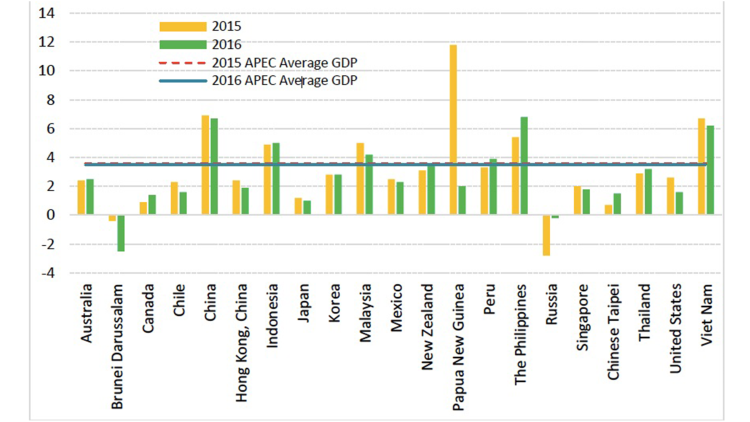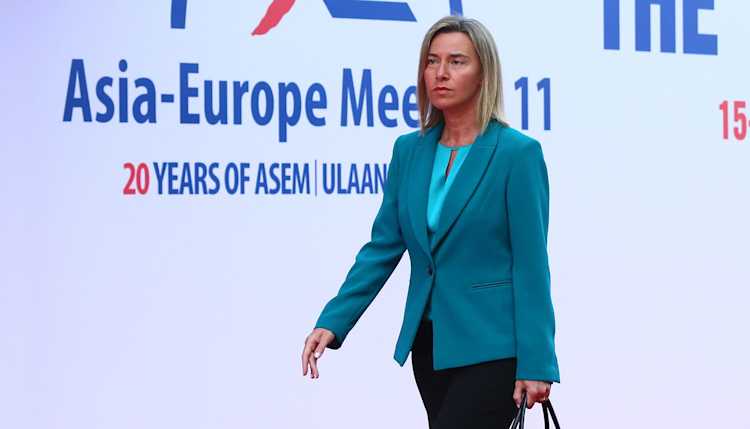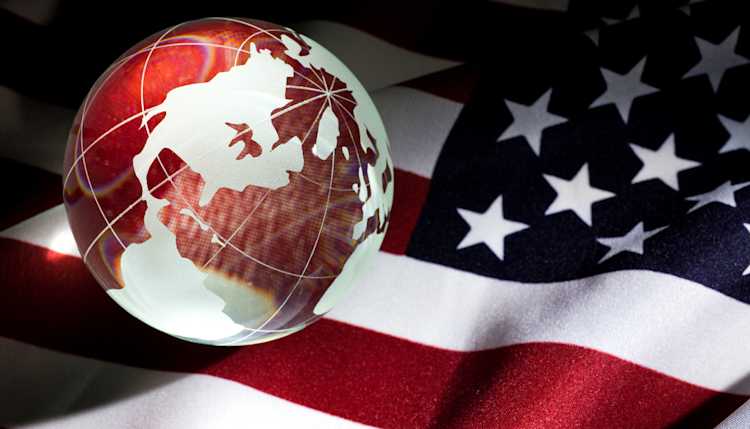- Home
- Publications
- GIGA Focus
- Vietnam Navigates Change to Defuse APEC’s Internal Crisis
GIGA Focus Asia
Vietnam Navigates Change to Defuse APEC’s Internal Crisis
Number 5 | 2017 | ISSN: 1862-359X

The Asia-Pacific Economic Cooperation (APEC) forum is at a critical juncture caused by Washington’s withdrawal from the Trans-Pacific Partnership and Beijing’s support for the Regional Comprehensive Economic Partnership. As the APEC Chair in 2017, Vietnam is urging members to focus on “Creating New Dynamism, Fostering a Shared Future,” renewing APEC’s agenda, and reaffirming objectives central to its development.
After a solid start and initial achievements, APEC has often been criticised for its slow delivery of tangible outcomes in regional trade and investment liberalisation. In 1994, APEC agreed to create a free trade and investment zone by the two-stage deadlines of 2010 for developed members and 2020 for developing economies. APEC is viewed as failing to expedite this agenda and as having credibility and identity crises.
The “flexibility” principle has caused sharp divisions within APEC: trade liberalisation energised by neoliberal ideologies and structural reforms on the one side, and economic and technical cooperation underpinned by developmentalist ideologies on the other. The APEC agenda has been swinging between different priorities depending on which member is chairing APEC in a given year. Such wavering has added to its identity crisis.
The APEC Summit in November 2017 is under pressure to deliver a bold initiative to revitalise the forum and handle Trump’s protectionism. Vietnam is striving to strike a balance between liberal trade and development. The four priorities – sustainable and inclusive growth, regional economic integration, digitalisation, and sustainable agriculture in response to climate change – demonstrate the host’s attempt to align APEC with global agendas, reassert APEC’s relevance, and defuse its internal crisis.
Policy Implications
The road to freer trade in APEC looks bumpy. Although the United States has yet to clarify its new relationship with APEC, a likely outcome is that Asia may choose to transform APEC into an Asia-led grouping and balance US unilateralism via closer ties with the EU. The door is open for the EU to reinforce its focus on Asia. If so, the Asia-Europe Meeting (ASEM) might be enhanced at APEC’s expense.
APEC and Its Internal Crisis
APEC came into being in 1989 as a regional economic grouping intended to promote trade and investment in the Asia-Pacific region. It started out as an informal ministerial-level meeting of 12 economies and within the first decade it developed into a transregional grouping of 21 economies. Together they represented approximately 60 per cent of world GDP and 50 per cent of world trade in 2015. APEC members include the world’s largest economies – the United States, China, and Japan – and a number of the world’s fastest growing economies (see Figure 1).

Since 1993 APEC has evolved from a loosely structured forum into a more institutionalised and goal-oriented grouping, with an annual APEC Economic Leaders’ Meeting that provides greater strategic vision for regional cooperation. At the 1994 summit in Indonesia, the leaders set the ambitious target of creating a free and open trade and investment region – by 2010 for developed economies and by 2020 for developing economies. This set of goals was known as the Bogor Goals (Berger 1999).
Looking back almost three decades, enthusiastic regionalists may regard APEC as a successful forum for economic and social advancement, measured in the growth of activity, trade and investment, and confidence-building in the region. The rapid economic growth of China and Vietnam has been attributed in part to their involvement in APEC. APEC has also been considered an arena for geo-economic strategies which focus on the use of economic instruments to create not only prosperity but also stability and peace in the region. APEC’s pragmatic and flexible approach to trade liberalisation has achieved progress in business mobility, customs procedures, standards and regulations, and government procurement. Despite the organisation’s informal and voluntary institutional mechanisms, 14 APEC economies have implemented various stages of the Single Window system – a big step towards an integrated market in investment and customs procedures – and average tariffs fell from 17 per cent in 1989 to 5.6 per cent in 2014 (APEC 2017). Tariff reductions have also been implemented in many sectors, beyond and ahead of the WTO negotiations – for example, via the 2001 agreement to voluntarily liberalise tariffs to no more than 5 per cent on environmental goods under the APEC list of 54 product categories (Vossenaar 2016; Yamazawa 2012).
APEC is a large and complex grouping, with over 40 subcommittees and working groups as well as several hundred meetings and projects underway each year. However, APEC’s numerous meetings have often been seen as “talk shops” or “summit fashion shows,” and the acronym has even been interpreted as “A Perfect Excuse to Chat” due to the organisation’s slow and poor delivery of tangible outcomes. In its first two decades, APEC proved to be an informal regional forum for dialogue, consultation, and recommendations rather than a policy-coordinating and rule-making body with a capacity for crisis management. Notably, APEC’s credibility and relevance were challenged by its failure to deal with the Asian financial crisis of 1997–1998. This credibility crisis was particularly fuelled by the collapse of APEC’s attempt to implement the voluntary sectoral liberalisation suggested by the United States but opposed by Japan. The plethora of declarations, plans, and action agendas did not deliver substantive outcomes. Consequently, APEC changed from a site for an emerging East–West synthesis to a site for a new East–West divide. More recently, APEC activities have increasingly reflected competing geo-economic and geopolitical visions. On the one hand, the establishment of the Trans-Pacific Partnership (TPP) led by the Obama and Abe administrations has experienced a setback with Trump’s withdrawal in January 2017. On the other hand, China has exhibited strong support for the Regional Comprehensive Economic Partnership (RCEP) initiated by Indonesia. These new regional trade deals have further complicated the direction of APEC’s development. Thus, APEC appears to be suffering from a serious identity crisis.
Although the Bogor Goals have been raised repeatedly at the annual summits, differences persist among APEC members in terms of their views and priorities regarding APEC’s two main pillars: Trade and Investment Liberalisation and Facilitation requiring structural reforms on the one hand, and Economic and Technical Cooperation emphasising inclusive development on the other. Consequently, the weight that members attach to regional activities differs. Furthermore, APEC’s non-binding nature allows members to choose whether or not they implement recommendations, to outline their preferences, and to set their own timetables. The APEC agenda has switched between different priorities depending on which country has chaired APEC in a given year. APEC has claimed to pursue a free trade programme with an “open regionalism” principle that extends the same treatment to non-APEC members, but this unconditional and unreciprocal principle has caused considerable controversy among APEC members and limited the willingness of some members to proceed with APEC’s liberalisation policies (Wang and Coyle 2002).
In practice, APEC members avoid potential free-rider problems by granting each other bilateral free trade agreements (FTAs). The proliferation of bilateral FTAs has increased the cost of doing business due to inconsistencies between various elements of the agreements, such as different schedules for phasing out tariffs, different rules of origin, conflicting standards, exclusions, and different rules for dealing with disputes. The discrepancies between declarations and implementation have further added to APEC’s credibility crisis.
In brief, although some observers may still see APEC’s strength in its voluntary and informal processes, more people view APEC as standing at a crossroads and struggling with internal crisis. The twin crises of credibility and identity stem primarily from a lack of consensus over the grouping’s objectives and an absence of institutional capacity to drive the organisation (Park and Lee 2009; Ravenhill 2000). APEC members are attempting to overcome these crises by taking initiatives to build new regional institutions within the grouping.
APEC’s Regional Trade Deals: Geo-Economics Forges Geopolitics
The 2010 APEC Summit in Japan reviewed the progress towards the Bogor Goals and decided to take concrete steps to realise the Free Trade Area of the Asia-Pacific (FTAAP). Since then APEC has become an arena for different geo-economic strategies, as reflected in different regional trade deals such as the TPP and the RCEP. These trade deals claim to be pathways to the overarching transregional trade area – FTAAP – but each constitutes a distinct geopolitical vision.
The TPP originates from the “Pacific Four” (P4) Group’s FTA, formed in 2006 between Chile, New Zealand, Singapore, and Brunei. The United States and other members had joined by 2008, but due to the US election, the first public announcement of the trade deal was made by the Obama administration in 2009 and the first round of negotiations started in early 2010. After five years of negotiations, the TPP agreement, with 6,000 pages affecting more than 18,000 tariffs, was signed in February 2016 by the United States, Japan, Australia, New Zealand, Canada, Malaysia, Vietnam, Singapore, Brunei, Mexico, Peru, and Chile. In its most lofty form, the TPP could have created a new single market among the 12 countries, similar to the European Union, representing approximately 40 per cent of the global economy. The TPP aimed to be a comprehensive agreement with high-quality rules on trade and investment, the environment, and labour. It adhered more strictly to free trade and intellectual rules than the WTO. It also introduced the “Investor-Sate Dispute Settlement” mechanism, which would allow companies to sue states for violations of investment contracts.
The Obama administration invested considerable political capital in pushing for the TPP and driving APEC away from its original informal and voluntary norms towards a legally binding mechanism. If the TPP were launched, the US would have succeeded in transforming APEC into a regional institution of the type that the US has long desired. The TPP has partly been seen as a revival of the original APEC free trade plan. The striking difference from the original APEC plan is the exclusion of China, although China has declared interest in the TPP and is paying close attention to it (Devadason 2014).
Trump has signed an executive order formally withdrawing the United States from the TPP, but APEC members appear to have other regional trade deals backed by China in place. APEC has thus become a useful arena for China, not only for countering the US strategy but also for pushing its own version of an economic alliance: the Asia-centric RCEP is seen as a short-term step towards FTAAP. China has signalled its determination to transcend the short-term separation between the “East Asia” and “trans-Pacific” tracks in order to embrace Asia-Pacific regional integration in the long term, including both itself and the United States (Scollay 2016). At the 2014 APEC Summit in Beijing, China proposed a roadmap to FTAAP, but the United States did not want the Beijing initiative to eclipse the TPP, which was then entering the final stage of negotiations. The summit witnessed the United States and China wrestling to win over other APEC members to their respective geo-economic proposals: Obama’s TPP and Xi Jinping’s FTAAP.
The United States’ objection to the Beijing Roadmap to FTAAP made China turn to its current regional trade priority, the RCEP. The RCEP was initiated by Indonesia in 2011 as a middle way between two other regional trade deals proposed by China and Japan under the framework of ASEAN+6 (China, Korea, Japan, India, Australia, and New Zealand). The RCEP aims to harmonise the existing and overlapping bilateral FTAs between the 16 Asian countries (see Figure 2).
In 2015 China again used APEC as an arena for its strategy. At the margin of the 2015 APEC Summit in Manila, China signed up 15 RCEP countries (except Japan) as founding members of the Asia Infrastructure Investment Bank (AIIB), which is projected to provide major development aid for the China-led Belt and Road Initiative. The RCEP (and AIIB) can be seen as China’s response to the TPP and as the reaction of some major ASEAN economies such as Indonesia and Thailand which are not yet signatories of the TPP.

Vietnam was set to be one of the major beneficiaries of the TPP. To save the agreement, Vietnam has worked with the other signatories to convince them that it is worth staying with the agreement, even without the United States. So far none of the remaining 11 members has shown signs of withdrawing from the TPP. Japan and New Zealand ratified the TPP agreement in January and May 2017, respectively. According to an official statement, Japan “intends to continue to tenaciously encourage other original signatories to promptly complete their domestic procedures toward the entry into force of the TPP agreement, in light of the significance of the TPP” (Japanese MOFA 2017). New Zealand has also sent a clear message that the path is open for the United States to rejoin if it changes its mind and for other economies that can accept the high standards of the TPP (McClay 2017). Alongside the APEC trade ministers’ meeting in May 2017, Vietnam hosted a separate meeting of the 11 remaining TPP signatories. The first outcome of that meeting was a joint statement on launching a process to assess options for bringing the agreement into force expeditiously. The possible options will be discussed when the ministers meet again on the margins of the APEC Summit in November 2017 in Vietnam.
In sum, the challenge to APEC regional economic integration is that the grouping’s shared objective risks being diminished due to a “national interests first” approach. Therefore, the key rationale for APEC is being tested. Trump has confirmed his participation in the upcoming APEC Summit, at which he is expected to clarify the United States’ new relationship with APEC. However, dealing with an unsupportive key member may ultimately lead the other members to question the relevance of the United States for APEC.
Vietnam Navigates Change: Why and How?
Joining APEC in 1998 was a key step in Vietnam’s international economic integration, and hosting APEC for the second time after a decade is a top priority for Vietnam in 2017. Vietnam’s Ministry of Foreign Affairs reports that 13 out of 16 FTAs Vietnam has signed or is negotiating are with APEC members. Its top-five export destinations are the United States, China, Japan, Korea, and Hong Kong. Nine of the top-ten foreign investors in Vietnam are Korea, Japan, Singapore, Chinese Taipei, Hong Kong, Malaysia, the United States, China, and Thailand. And 80 per cent of Vietnamese students abroad are studying in APEC countries, mainly Japan, Australia, the United States, China, Canada, and Singapore.
“The APEC region has always been a corner-stone of our foreign policy. The future of the Asia-Pacific is the future of Vietnam.” This statement, made at an APEC meeting in May 2017 by Vietnam’s deputy prime minister cum foreign minister, Mr. Pham Binh Minh, explains the necessity that Vietnam navigate change in order to boost the momentum of this regional grouping and mitigate its internal crises. Renewing the APEC agenda is a significant condition for reaching consensus among its members. In an interview with the Oxford Business Group, Mr. Pham stated, “as the host economy, Vietnam will play a significant role in defining themes, priorities and cooperation agendas for APEC in 2017. Together with other APEC members, we will create new dynamism for regional connectivity and growth, and foster the role of APEC as the leading economic cooperation mechanism in the Asia-Pacific region” (Pham, quoted in Oxford Business Group 2017).
As a member of both the TPP and RCEP, Vietnam is well aware that setting the agenda for APEC 2017 in a challenging regional geopolitical environment requires much deliberation and international support. While preparing to take over the APEC chairmanship, Vietnam was invited to participate in the G20 meetings in Germany, which have been taking place since the end of 2016. One Vietnamese senior official shared, “this is the first time Vietnam is invited as the APEC chair and we are invited not only to the G20 Summit but also to participate in several ministerial and high-level meetings, especially the Sherpa meetings from last December, including the consultation process for drafting the G20 Declaration” (Interview 5 July 2017).
At the G20 meetings, Vietnam had an opportunity to share the achievements and challenges in leading the APEC agenda. For instance, the APEC trade ministers’ meeting in May was unable to reach a joint statement, and a Chair’s statement was issued instead. Vietnam is trying to create synergy between the G20 and APEC agendas; therefore, it makes sense for the country to draw on the experience of the G20 negotiations in order to better understand the positions of almost half of the APEC members, which are also G20 members. This exposure to global multilateral cooperation in general and the opportunity to socialise with international partners have, to a certain extent, given Vietnam the impetus to strengthen its APEC chairmanship, including its negotiation capacity, while also securing its international support.
Vietnam has decided on the four-point agenda for APEC this year. It covers sustainable, innovative, and inclusive growth; regional economic integration; digitalisation; and sustainable agriculture in response to climate change. This agenda has shown the host’s effort to link APEC with global agendas in the hope of achieving consensus among all APEC members. During its APEC chairmanship since the beginning of this year, Hanoi has been striving to raise the quality and effectiveness of its multilateral diplomacy to a higher level and to introduce the world to a reformed and dynamic Vietnam that is taking an active part in building and shaping multilateral institutions.
However, while acknowledging the uncertain future of the TPP, the Vietnamese official quoted above did not conceal the fact that the Vietnam–EU FTA and the strong Vietnam–Germany partnership were also rationales behind the country’s invitation to and participation in the G20. Prior to the G20 Summit, the Vietnamese prime minister’s visit to Germany, which was accompanied by a “road show” of some 200 Vietnamese enterprises, demonstrated the country’s attempt to diversify its trade partners and reduce its heavy dependence on the APEC trade deals, especially the TPP. The Vietnam–EU FTA, which was signed in 2015 and is expected to come into effect in 2018, will eliminate nearly all tariffs, including tax on fisheries, pharmaceuticals, and chemicals. This FTA is expected to contribute an additional 8 per cent to Vietnam’s GDP by 2025. In this context, Vietnam has invited Germany to participate in the upcoming APEC Summit, marking the first time a European country has been asked to attend.
Possible Scenarios
Given the current rise of protectionism, the path to freer trade within APEC is uncertain. There are two scenarios. The first is that the Asian members choose to transform APEC into an Asia-led grouping and keep open the relationship with the United States. This would mean that APEC would continue to further its agenda, which combines both trade liberalisation and development cooperation, but would involve the United States to a certain extent – without letting it influence the agenda and processes. One consequence of such an approach would be the growing irrelevance of the United States for APEC on the core issues. Although the 11 APEC members have yet to announce their decisions about the TPP’s future, one challenge for the TPP to take effect is to change the condition requiring at least six countries representing 85 per cent of the original signatories’ GDP to ratify the agreement within two years of signing. The Japanese prime minister has said, “there is no doubt that there would be a pivot to the RCEP if the TPP does not go forward. The RCEP does not include the US, leaving China the economy with the largest gross domestic product” (Kyodo 2016).
The second scenario, complementing but not replacing the first, is that Asian APEC members and Europe strengthen their partnership under the Asia-Europe Meeting (ASEM) framework. This year has witnessed the resurrection of Asia–Europe trade talks. In March, EU Trade Commissioner Cecilia Malmström and the ASEAN economic ministers announced that they wish to revive plans for an FTA. The commissioner said, “having a region-to-region agreement between EU and ASEAN is a long-term goal we’ve been discussing for many years. We are now taking steps towards this” (Deutsche Welle 2017).
The EU and ASEAN launched a bi-regional trade deal in 2007, but the process was halted in 2009. The EU opted instead to conduct bilateral negotiations with individual ASEAN countries. So far, the EU has signed FTAs with Singapore and Vietnam, and negotiations are underway with Indonesia, Malaysia, the Philippines, and Thailand. In a similar vein, in July the EU and Japan reached two landmark agreements, the Economic Partnership Agreement and the Strategic Partnership Agreement. In September, the free trade talks between the EU, Australia, and New Zealand were agreed to be on fast track. Will all these FTAs with the EU help raise the standards for the China-supported RCEP and enhance the EU’s leadership in setting global trade rules?
Implications for Europe
The opportunity is open for Europe to seize and reinforce its focus on Asia. In May this year, high-level Asian and European officials resumed their trade talks to further the open and rules-based multilateral trading system and asserted their commitment to fighting protectionism and unfair trade practices. In September 2017, the 7th ASEM Economic Ministers’ Meeting took place in Korea after a 12-year hiatus. Under the theme “Reconnecting Asia-Europe: Innovative Partnership for Inclusive Prosperity,” the meeting focused on (a) facilitating and promoting trade and investment, (b) strengthening economic connectivity, and (c) fostering sustainable and inclusive growth. This ASEM trade meeting laid the foundation for discussions at the ministerial conference of the WTO, to be held in December this year (ASEM 2017).
The ministers also made plans to revitalise the ASEM Trade Facilitation Action Plan and the ASEM Investment Promotion Action Plan. They also supported the work of the newly established ASEM Pathfinder Group on Connectivity, which aims to enhance physical connectivity (transportation), institutional connectivity (rules and regulations), and people-to-people connectivity (knowledge and culture). The ASEM digital connectivity initiative has inspired the ministers to take stock and implement further steps to revitalise the work on e-commerce in the WTO. The ASEM physical connectivity initiative has seen the emergence of the EU-ASEAN Comprehensive Air Transport Agreement as a result of the concrete negotiations in 2016 and 2017. ASEM also discussed the great trade and investment potential of cross-border energy networks in the ASEM region, as part of which quality infrastructure investment and social and environmental impacts are of interest and concern for both Asia and Europe. The ASEM people-to-people connectivity will be further enhanced by the upcoming ASEM Education Ministers’ Meeting in Seoul in November, which will mark one decade of ASEM higher education cooperation.
ASEM also offers a broader platform for the EU to coordinate actions and to discuss the Chinese Belt and Road Initiative, for which 14 EU countries (Austria, Denmark, Finland, France, Germany, Hungary, Italy, Luxembourg, Malta, the Netherlands, Poland, Portugal, Sweden, and the United Kingdom) have signed up as founding members of the Asia Infrastructure Investment Bank (AIIB website). As part of the Belt and Road Initiative, China and 16 Central and Eastern European countries (11 EU and 5 non-EU states) have established the “1+16” group for cooperation (www.china-ceec.org). Some infrastructure projects have been agreed within this new group – for example, the modernisation of the Budapest–Belgrade high-speed rail line. A more coordinated European response would be desirable to prevent possible infringement of the EU rule on government procurement. Moreover, possible forms of cooperation, such as high-level sectoral meetings, should be considered. The third ASEM Transport Ministers’ Meeting in Riga in 2015 was well attended, but the fourth meeting in September of this year in Indonesia was not well attended by the European ministers (only six).
These various activities have important implications for Europe and Asia. Depending on how substantive and binding an economic partnership the EU wants to achieve, the ASEM framework may work well with the RCEP because they share the advantage of being based on the consensus model, which is flexible and accommodating for all involved. In summary, both scenarios send a powerful signal that cooperation, not protectionism, is the way to overcome crisis and tackle global challenges.
Footnotes
References
APEC (2017), Achievements and Benefits, www.apec.org/About-Us/About-APEC/ Achievements and Benefits.aspx (10 October 2017).
APEC Policy Support Unit (2017), APEC Regional Trends Analysis (Globalisation: The Good, the Bad, and the Role of Policy), Singapore: APEC Policy Support Unit.
ASEM (2017), The 7th ASEM Economic Ministers’ Meeting (ASEM EMM7) Chair’s Statement, Seoul: ASEM.
Berger, Marc T. (1999), APEC and Its Enemies: The Failure of the New Regionalism in the Asia-Pacific, in: Third World Quarterly, 20, 5, 1013–1030.
Deutsche Welle (2017), EU, ASEAN Ready to Restart Free Trade Talks, 10 March.
Devadason, Evelyn S. (2014), The Trans-Pacific Partnership (TPP): The Chinese Perspective, in: Journal of Contemporary China, 23, 87, 462–479.
Japanese MOFA (2017), Notification of Completion of Domestic Procedures for the Trans-Pacific Partnership (TPP) Agreement, Ministry of Foreign Affairs of Japan, www.mofa.go.jp/press/release/press4e_001443.html (10 October 2017).
Jozuka, Emiko (2017), TPP vs RCEP? Trade Deals Explained, CNN, 26 January, http://edition.cnn.com/2017/01/24/asia/tpp-rcep-nafta-explained/ (10 October 2017).
Kyodo (2016), Abe Warns TPP Impasse would Shift Focus to China-inclusive Trade Pact, in: The Japan Times, 15 November.
McClay, Todd (2017), Trans-Pacific Partnership (TPP) Agreement Ministerial Statement, 21 May, The official website of the New Zealand Government, www.beehive.govt.nz/release/trans-pacific-partnership-tpp-agreement-ministerial-statement (10 October 2017).
Oxford Business Group (2017), Pham Binh Minh, Deputy Prime Minister and Minister of Foreign Affairs: Interview, www.oxfordbusinessgroup.com/interview/pham-binh-minh-deputy-prime-minister-and-minister-foreign-affairs/vietnam-2017 (10 October 2017).
Park, Sun-Hoon, and Jeong Yeon Lee (2009), APEC at a Crossroads: Challenges and Opportunities, in: Asian Perspective, 33, 2, 97–124.
Ravenhill, John (2000), APEC Adrift: Implications for Economic Regionalism in Asia and the Pacific, in: Pacific Review, 13, 2, 319–333.
Scollay, Robert (2016), APEC, TPP, and RCEP: Towards an FTAAP, in: Basu Das Sanchita and Masahiro Kawai (eds), Trade Regionalism in the Asia-Pacific, Singapore: ISEAS Publishing, 297–322.
Vossenaar, Rene (2016), Reducing Import Tariffs for Environmental Goods: The APEC Experience, Geneva: International Centre for Trade and Sustainable Development.
Wang, Zhi, and Bill Coyle (2002), APEC Open Regionalism and Its Impact on the World Economy: A Computable General Equilibrium Analysis, in: World Economy, 25, 4, 563–589.
Yamazawa, Ippei (2012), APEC New Agenda in Its Third Decade, Singapore: Institute of Southeast Asian Studies.
General Editor GIGA Focus
Editor GIGA Focus Asia
Editorial Department GIGA Focus Asia
Regional Institutes
How to cite this article
Dang, Que Anh (2017), Vietnam Navigates Change to Defuse APEC’s Internal Crisis, GIGA Focus Asia, 5, Hamburg: German Institute for Global and Area Studies (GIGA), http://nbn-resolving.de/urn:nbn:de:0168-ssoar-54477-8
Imprint
The GIGA Focus is an Open Access publication and can be read on the Internet and downloaded free of charge at www.giga-hamburg.de/en/publications/giga-focus. According to the conditions of the Creative-Commons license Attribution-No Derivative Works 3.0, this publication may be freely duplicated, circulated, and made accessible to the public. The particular conditions include the correct indication of the initial publication as GIGA Focus and no changes in or abbreviation of texts.
The German Institute for Global and Area Studies (GIGA) – Leibniz-Institut für Globale und Regionale Studien in Hamburg publishes the Focus series on Africa, Asia, Latin America, the Middle East and global issues. The GIGA Focus is edited and published by the GIGA. The views and opinions expressed are solely those of the authors and do not necessarily reflect those of the institute. Authors alone are responsible for the content of their articles. GIGA and the authors cannot be held liable for any errors and omissions, or for any consequences arising from the use of the information provided.













